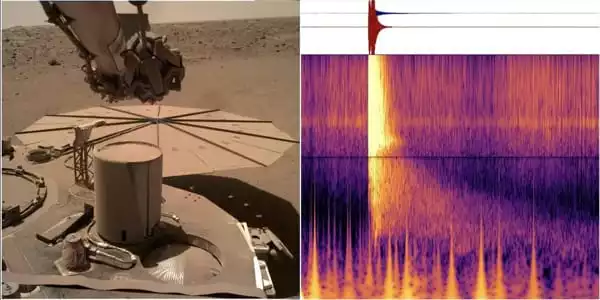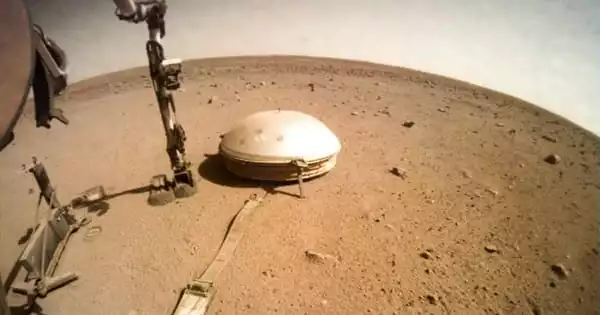On May 4, a magnitude 5 earthquake struck the surface of Mars, the biggest temblor ever observed not only on Mars, but on any planet other than Earth. The marsquake, discovered by NASA’s InSight lander, outperformed the previous record-holder, a 4.2-magnitude quake in August 2021.
“NASA InSight’s scientists and partners have just received preliminary data from Mars on what is thought to be the most seismic activity ever recorded on another planet!” Thomas Zurbuchen, NASA Associate Administrator for Science, announced the news on Twitter. “Preliminary assessment: a magnitude 5 event. Teams must be patient as they study the data.”
A magnitude 5 earthquake would be considered minor on Earth. Such earthquakes occur half a million times per year on our planet and rarely inflict significant damage. (According to the Los Angeles Times, they may throw items off shelves, smash windows, and wake you up at night.) Mars, on the other hand, has far more calm tectonics, and a magnitude 5 earthquake is about as powerful as scientists hoped for when they deployed InSight to the Red Planet in 2018.
“We’ve been waiting for ‘the big one’ since we set down our seismometer in December 2018,” said Bruce Banerdt, InSight’s principle investigator at NASA’s Jet Propulsion Laboratory in California, which manages the mission. “This quake is sure to provide a view into the planet like no other.”
The team still knows very little about the record-breaking marsquake and will have to study the data to establish its location and cause.
We’ve been waiting for ‘the big one’ since we set down our seismometer in December 2018. This quake is sure to provide a view into the planet like no other. NASA InSight’s scientists and partners have just received preliminary data from Mars on what is thought to be the most seismic activity ever recorded on another planet!
Bruce Banerdt
On November 26, 2018, InSight landed at the Elysium Planitia, a vast plain spanning the planet’s equator, and was outfitted with a highly sensitive seismometer built by the French space agency CNES. The gadget detects and analyzes seismic waves flowing through Mars’ geological strata, allowing geologists to remotely peer into the planet’s interior. Geologists can determine the depth and composition of these layers: the crust, mantle, and core, by comparing what they see on Mars with what they know about the behavior of seismic waves on Earth.
InSight has identified over 1,313 marsquakes in its roughly 1,300 days on Mars. The main mission of the lander concluded in 2020, however NASA has since extended it. However, the lander is having difficulty capturing enough solar electricity to keep running. The amount of dust in the air has increased substantially since InSight’s arrival due to seasonal weather patterns, obscuring the sun.
Back in January, a local dust storm forced the spacecraft into safe mode, raising concerns about how long the mission may last. And, just a few days after its new powerful discovery, on May 7, the spacecraft experienced another dangerously low level of power.

How marsquakes work
Teasing out results from InSight’s data represents a major analytical feat. On Earth, seismology is performed with networks of tens of thousands of sensors. InSight scientists had a single seismometer, in a single location, with which to peer into the red planet’s interior.
Mars is deathly still in comparison to Earth, adding to the challenge. The largest shocks on Mars would be hardly felt by individuals on the surface unless they were standing within a few kilometres of the epicenter. However, InSight is extraordinarily sensitive, and the seismic silence of Mars allows the spacecraft to detect mild tremors at greater distances than a comparable device on Earth. Despite this, scientists have had to battle with a slew of potential noise sources, including surface winds, dust devils, and “glitches” created by InSight’s creaking, popping structure as it heats up and cools down with each Martian day.
“With the fantastic team we have, we were able to dig out all of the information that we wanted to from the data that we did get and that we’re still collecting,” says co-author Mark Panning of NASA’s Jet Propulsion Laboratory in Pasadena, California.
Any seismologist on Earth would recognize the bread and butter of marsquake researchers: P-waves and S-waves are two forms of seismic waves that go through the interior of a planet. P-waves, like sound waves flowing through air or water, compress particles along their courses. S-waves travel at a slower rate than P-waves, and as they pass through a material, they shake the particles side to side, much like the strings of a freshly strummed guitar.
P- and S-waves do not travel through the same materials because they flow in distinct directions, providing scientists with important information about the innards of planets. P-waves can move freely through solids, fluids, and gases, whereas S-waves can only move through solids because materials resist side-to-side shearing.
This distinction was critical in discovering Mars’ core since P-waves can penetrate through a solid mantle and into a liquid core while S-waves cannot. Some S-waves can even descend to the core-mantle barrier, reflect off it without losing energy, and rebound upward toward the surface, depending on the orientation of their side-to-side shaking.
















